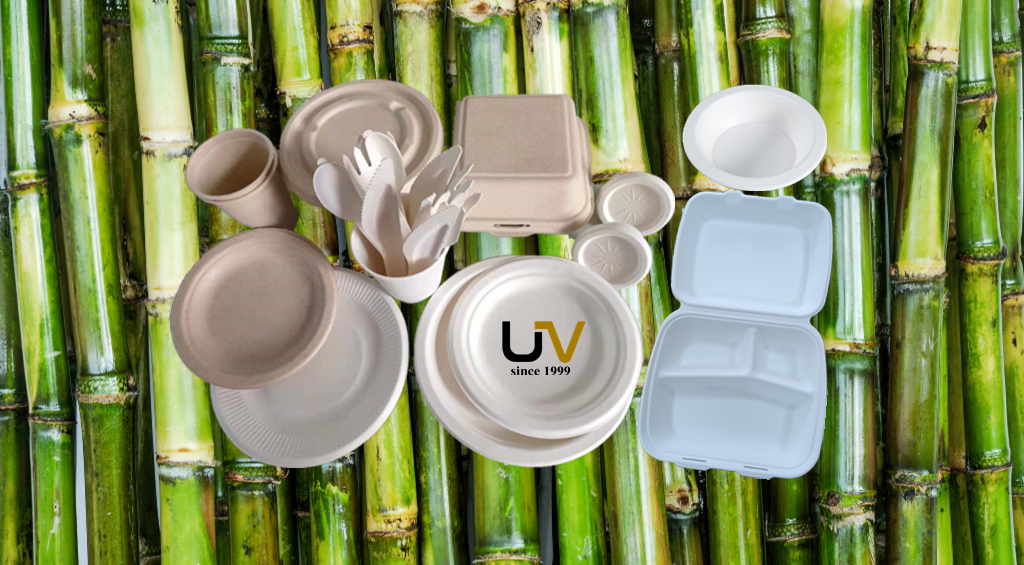Putting an end to pollution, and taking good care of the earth is an important topic in the modern world. It is impossible to see what is going on under the surface of our oceans with a naked eye. By far, plastic pollution is one big issue, that’s why many countries start to bidden using plastic packaging parts. Relevant literature has come out in the industry of disposable tableware.
As we all know, Disposable fast food boxes are loved by people for their ease of use and can be found everywhere in daily life. Most of the disposable fast food boxes on the market are made from polystyrene, a raw material extracted from petroleum, plus a foaming agent, which is heated and foamed. Polystyrene is an extremely widely used polymer material with low toxicity, high melting point, high plasticity, and easy production, thus becoming the material of choice for disposable fast food boxes. However, when the temperature of the ingredients do more than 60 degrees, polyurethane foam plastic tableware will release harmful substances, this material will cause some harm to the human liver, kidney function, and the body’s central nervous system, seriously endangering everyone’s physical and mental health. More seriously, disposable plastic tableware will not only have the above-mentioned ills but also because of people’s random discard and cause serious white pollution.
So plastic tableware is not a good choice, while the fully degradable disposable bagasse tableware does not have the above-mentioned disadvantages, that’s why Sugarcane bagasse pulp disposable tableware walks into the public line of sight more and more. It is made using waste bagasse paper pulp as raw material, the production process does not need to add any catalyst, and the production process is simple, the compostable bagasse pulp disposable tableware made from waste bagasse cellulose has high tensile strength and better thermal stability, the production process is pollution-free. And the waste meal box can be completely decomposed into CO2 and H2O.
WHAT IS SUGARCANES?
Sugarcane is found in tropical climates since this is where it thrives, it is a tall and relatively strong class of perennial grasses that are known to have high sugar content, it’s perhaps best known as being the source for white sugar, but it is also a source of biofuel and syrup. It belongs to a family of sweet grasses, and in the proper conditions, sugarcane can reach heights of up to 13 feet (4 m). The harvesting of around 100 tons of sugarcane can generate approximately 10 tons of sugar plus 34 tons of bagasse. It is a highly popular resource used worldwide, for the production and manufacturing process of retail sugar. The bagasse would normally be considered as the waste material and burned, but if it gets generated into eco-friendly packaging products instead, the creation of bagasse packaging will increase its value.
Sugar cane can be divided into fruit cane and sugar cane according to its usage. Fruit cane is sugar cane exclusively for fresh consumption, which has the characteristics of less fiber, moderate sugar, juicy and tasty. Sugar cane has a high sugar content and is used as a raw material for sugar production. The very first sugar cane came from sugar cane. Modern medical research shows that sugar cane is rich in sugar and water, in addition to various vitamins, fats, calcium, and iron, which are very beneficial to human metabolism. It has the efficacy of clearing heat and detoxifying the body, quenching thirst, harmonizing the stomach and stopping vomiting, nourishing Yin and moistening dryness, and was loved by many people in ancient times. Sugar cane is also the only fruit with stems among fruits, and because of its rich nutrition, it is called the best of fruits.
WHAT IS BAGASSE?
Bagasse is an organic waste product, another name for bagasse is megass, from a root term that originally meant rubbish. Instead of creating air pollution by burning it, however, new uses for it continue to flourish. Bagasse comes from sugarcane, a large portion of sugarcane is converted to bagasse since it is the fibrous content of the plant itself. It is estimated that about 30% of sugarcane is recovered as bagasse. Once stalks are harvested, they are pressed to extract their juices, and these juices are then processed and turned into sugar. During this process, a dry fibrous substance is left behind.
Uses of bagasse
I. Sugarcane bagasse can be turned into feed. After bagasse is recycled, bagasse can be mixed with urea, etc., then fermented, and finally dried and ground into powder, which can be used as feed to raise cattle, raise, pigs, etc., because bagasse contains high sugar and nutrients.
II. Bagasse can be used to produce fuel, alcohol, etc. The cellulose in bagasse can be converted into sugar, and then made into alcohol, fuel, etc., which is considered to be the full use of sugarcane.
III. production of high-density composite materials. The chemical composition of sugarcane bagasse is similar to that of wood, which is a good raw material for board making. Use bagasse resources to produce high-density composite materials. Due to the small specific gravity of bagasse and good fiber quality, the boards made are high in strength and light in weight, while the boards and profiles produced are free from biological aggression, low in water absorption, and free from corrosion by seawater; good fireproof performance, good flame retardant properties, good mechanical processing properties, and decorative properties, suitable for furniture, construction, carriages, ships, packaging boxes, and other production industries. The product has strong plasticity, replacing different molds or templates to directly produce a variety of panels and profiles, which has a great market value. The realization of high-density composite material technology not only solves the problem of agricultural waste and urban waste pollution emission but also saves limited forestry resources, which will definitely have a great impact on the environmental protection industry of China in the 21st century.
IV. Sugarcane bagasse can be used for paper making, board making, etc. At present, China has a high technology to make bagasse instead of wood as the raw material for manufacturing paper cups, mulch, pulp molded tableware, which can reduce the cutting of trees and protect the environment; it can also make disposable utensils into green environmental protection class of tableware. A heat source and pressure are used to mold this substance into a wide range of food packaging items, such as bagasse pulp food containers, takeaway boxes, dishes, clamshells, tableware, plates, and bowls.
ADVANTAGE OF BAGASSE PULP DISPOSABLE TABLEWARE
Bagasse pulp disposable tableware is made of 100% bagasse pulp, which can be recycled for papermaking and can be naturally degraded, and can solve the problem of white pollution caused by the use of polyphenylene glycol tableware for many years, which is considered the most promising new achievement; the tableware made of bagasse has high whiteness and tightness, good temperature and oil resistance, non-toxic and tasteless, and can be completely degraded within three months, and the production process is free from the generation of three wastes of pollution.
Being fully compostable and biodegradable, bagasse pulp disposable tableware has barely any impact on the earth, and its manufacturing process is also more sustainable since it requires very little energy to produce. It’s regarded as an eco-friendly product. Bagasse food packaging containers are great, that’s safe for kids because compare with many other materials, they are aesthetically pleasing, and they do not leave any residue, strong smells, or taste behind. This means that food and drink consumed from bagasse packaging have no lasting aroma that could impact the taste of its contents. And it’s 100% home compostable.
We know that clearly which systematically impact the environment long-term when using the tableware with material as styrofoam, plastics, and polystyrene. So, invest in biodegradable alternatives with less impact on the earth, is the right choice to take. Meanwhile, it’s also true that more people are aware of eco-friendly packaging alternatives these days and are trying to incorporate better choices into their own lives and lifestyles. Because of this, it’s up to the business to seek better options to cater to consumer needs and expectations. And bagasse is vastly becoming a trendsetter already.
IMPORTANTANCE FOR PROTECTING OUR EARTH
Saving our earth and its environment becomes highly important as it provides us food and water to sustain life, we should take care of the earth every day. Because it’s the only home we have. We want our kids to have the same beautiful earth we grew up with. This is where bagasse comes into play. As it’s a renewable resource material and the perfect alternative for disposable tableware, food containers since it’s much safer for the environment.
If we don’t try to protect the earth, our kids and their children will pay a heavy price in the future. So, it’s the important thing we should do, let’s take care of the earth like we take care of our kids. After all, it’s the only planet we have.
Protect the environment, everyone is responsible. Contact UV Tableware, let’s go hand in hand and create a low-carbon living.


